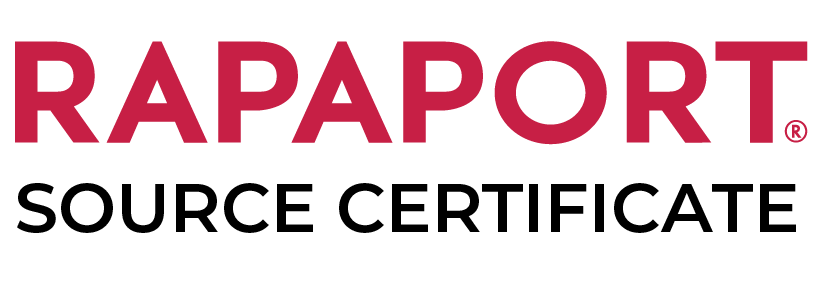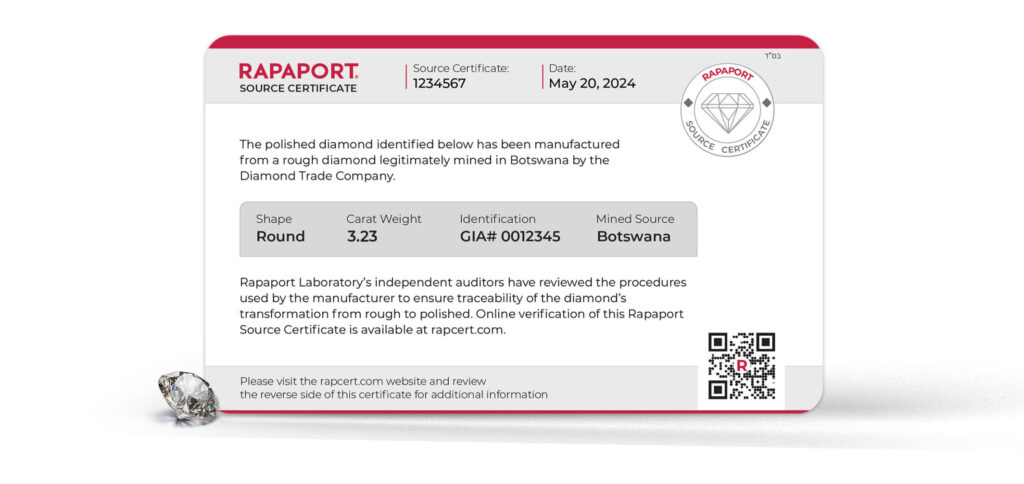Rapaport Source Certification
Article by Martin Rapaport
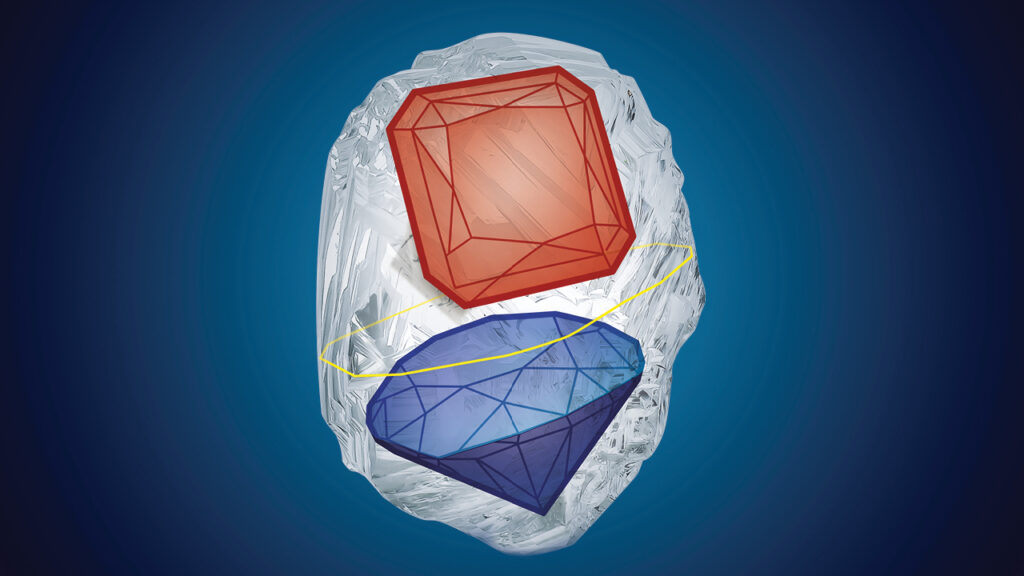
Source certification creates added value for good diamonds. A polished diamond with a trusted document that discloses where the diamond was mined is worth more money than a similar diamond from an unknown source.
While not everyone everywhere cares where their diamonds were mined, enough consumers, ethical retailers and brands do care. Source certification is required because bad diamonds that are involved with human rights abuses, money laundering and terrorist funding are mixed into the diamond pipeline. Furthermore, knowing where a diamond comes from empowers diamond sellers to promote good diamonds and tell the story about how good diamonds make the world a better place.
If you are a US consumer who has an opportunity to buy either a synthetic diamond made with solar energy, or a natural diamond from an unknown source that might be a blood diamond, which would you buy for an engagement ring? Now, let’s say you were also offered a diamond with a source certificate from Botswana, where diamonds support an entire country’s development, including healthcare, education, clean water, roads and future economic development. Which diamond would you buy? How much more is the good diamond worth than the unknown diamond? Source certification helps us capture that added value of good diamonds.
Emotional, social and legal added value
There are three types of added value that source certification provides: emotional, social and legal. The emotional added value is most important when the diamond gift celebrates emotional commitment. This is especially true for natural-diamond engagement rings, which are under extreme ethical attack and competition from synthetic diamonds. No bride wants to celebrate a diamond engagement ring that caused the death or rape of someone. It should be clear that the natural-diamond trade is fighting for its survival. The key battleground is the engagement ring market. Natural diamonds have already lost 2024 to synthetics, and we will lose 2025 if we do not resolve the ethical problem of blood diamonds.
Let me make it clear: There are many positive aspects to source certification, but there is a more dangerous negative aspect to not providing source certification. If we do not separate good diamonds from bad diamonds, the natural-diamond business as we know it today will cease to exist. We can’t make a living selling luxury products that cause death, rape, destruction or other severe human rights violations. The fact that almost all diamond trade organizations support the Kimberley Process (KP), which certifies blood diamonds as being legitimate, has set the stage for the destruction of our industry. If we do not separate good diamonds from bad diamonds, we do not deserve to be in business.
The positive emotional added value of source certification for good diamonds is not only a defense against bad diamonds. Source certification also creates real positive value. A woman receiving a diamond that can be shown to have made the world a better place is proud of the diamond, proud of her husband and proud of herself. She wears the diamond with honor and tells her friends the diamond’s story. Creating this emotional value is what the diamond business must be about. It is at the core of who we are and what we do.
Social added value transcends personal emotions, as it creates a groupthink based on society’s ethical values. Groupthink is extremely important as new generations of consumers develop new models of decision-making dominated by social media. Values are now more important and more easily manipulated. Truth and authenticity are vital marketing tools that have become difficult to communicate.
A key issue is that society now recognizes that we are responsible for how we spend our money. We are responsible for the unintended consequences of our purchases. It’s not just legal constraints related to money laundering or terrorist funding. Ethical considerations now control our consumption. Global warming is focusing us on environmental and other ethical group considerations. It’s not just theoretical; we feel the heat. Selling diamonds into this new world is a changed business. We dare not ignore societal norms of ethical behavior in a world where consumers move together like fish in trend groupings. Natural diamonds have become uncool due to ethical competition from synthetics and industry support of KP-certified blood diamonds. Source certification provides a lifeline for our good diamonds, ensuring that legitimate diamonds from legitimate sources catch the attention and desire of new generations of consumers.
Globalization and international economic cooperation are collapsing as East-West and North-South economic warfare develops. It’s not just Russia and Ukraine. Trade is being weaponized across the board. The West is coming to the realization that China is using its huge global trade surplus (approximately $3.37 trillion for 2020 to 2023) to militarize and seek global dominance in cooperation with Russia, Iran, North Korea and other non-Western nations. Essentially the world is breaking up economically if not yet militarily. There will be increasing economic sanctions and political boycotts that will impact the diamond, gem and jewelry business.
Source certification is important and can provide legal protection as responsible companies make honest efforts to meet sanction-compliance requirements. Unfortunately government agencies such as the US State Department are fundamentally dishonest (coming up with meaningless “Russian Origin” sanctions in 2022), and the US Office of Foreign Assets Control (OFAC), which is responsible for sanctions, creates irrational, misguided regulations that encourage the whitewashing of Russian-diamond imports. It is obvious that government regulators don’t know what they are doing and can’t be trusted. The best protection for legitimate companies is to ensure that they know and can document the sources of their diamonds.
How Rapaport Source Certification works
The foundation of source certification is traceability. This includes the ability to physically identify the diamond through scanning at all stages of production and trace the diamond’s journey from rough to polished. Once the polished diamond is uniquely identified through scanning and/or a laboratory grading report, a Rapaport Source Certificate (RSC) is issued. The RSC travels with the polished diamond through the supply chain like a grading report. In this manner, small to medium-size dealers and retailers can freely trade the diamond on the wholesale polished market. There is no need for verticalization of distribution from the mining company direct to the retailer.
While physical traceability is an absolute requirement, it is not a sufficient condition for Rapaport Source Certification. Diamonds must be sourced from reputable mines and manufacturing sources that apply ethical standards. For example, we would not provide an RSC for diamonds mined in Zimbabwe, no matter how good the traceability was. Also, we would not provide an RSC for diamonds from Angola unless we had audited the conditions of the specific mine source and the transfer of purchase funds to legitimate parties. At this stage, RSCs will only be provided for diamonds that are mined according to Responsible Jewellery Council (RJC) standards and manufactured by RJC-audited members. While we have ethical concerns about the RJC, we believe at this stage that they provide the best standards for ensuring the legitimacy of companies handling diamonds. Furthermore, we believe that declarative statements from companies should be independently audited.
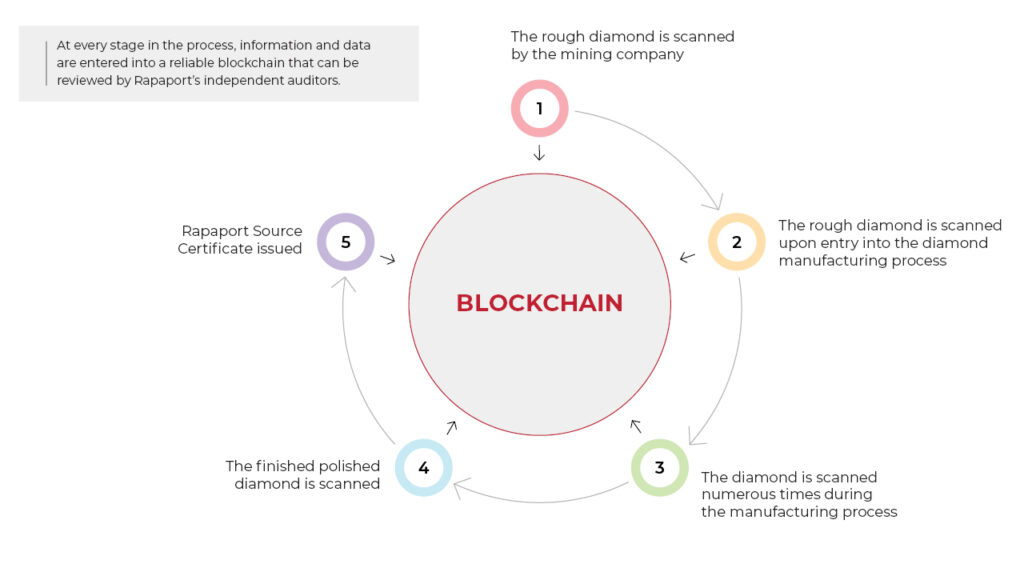
As outlined in our diagram, a key to traceability is the repeated scanning of the diamond throughout the production process. In addition, all of the scanned data must be uploaded to an authorized, independently auditable blockchain. All of the scanning and blockchain companies, technologies and systems must be approved by us and our independent auditors. Rapaport will initially support scanning and traceability reporting from the Gemological Institute of America (GIA), Sarine Technologies, Helix, De Beers and Tracr.
- The first step in traceability involves scanning the rough diamond. In most instances, the scanning will be done by the mining company or its scanning representative at the miner’s rough-distribution center. When De Beers consolidates shipments, the individual mine or country source might not be available. In such cases, the mine source for the diamond will be “DTC.” In all instances, the individual rough diamond will be scanned and its data uploaded to an approved blockchain.
- The rough diamond is transferred to the diamond manufacturer and scanned again. The manufacturer’s initial rough scan is compared and verified to match that of the mining company. The manufacturer’s scan is entered into the blockchain along with the unique identification number the mining company has assigned to the rough, and an additional unique identification number assigned to the rough by the manufacturer. In some instances, artificial intelligence can be used to match the mining company’s scan with the manufacturer’s scan.
- The diamond is scanned numerous times during the manufacturing process, enabling the auditors to prove that the uniquely identified polished diamond(s) came from the specifically identified rough diamond. The scans and their unique identification numbers and locations are uploaded into the blockchain for independent auditing. In addition, the independent auditors will have access to the manufacturer’s enterprise resource planning (ERP) system, letting them track the manufacturing process for diamonds receiving an RSC.
- The finished polished diamonds are scanned and given unique polished-diamond identity numbers. The final scan gets uploaded to the blockchain for future reference. In some instances, the diamonds may also be graded by approved diamond grading laboratories, and the grading report number will also be entered into the blockchain.
- A uniquely numbered Rapaport Source Certificate will be created and entered into the blockchain. All of the data about the polished diamond — including the miner’s and manufacturer’s rough scans, the production scans, and the final polished-diamond scan from the manufacturer — will be linked in the blockchain to the RSC. This will ensure that the auditors have the ability to trace the RSC diamond back to the original rough diamond.
The Rapaport Source Certificate is an independent document owned and operated by Rapaport Laboratories LLC. We will accept diamonds from qualified mining companies and use the technology of different scanning companies, blockchain companies and other resource providers that meet our standards and the standards of our independent auditors. While we are very concerned about the whitewashing of illegitimate diamonds by the Kimberley Process and other illegitimate source-certification systems, we will be open to honest tracing technologies and support legitimate existing auditing systems that meet our standards. We will be publishing a list of all approved companies and the systems we use as part of our RSC service.
Responsible business
At this time, the diamond trade is going through a very difficult transition period due to severe competition from synthetic diamonds. De Beers’ 2023 sales were down by 36%, and we expect a further 20% decline in 2024. By 2025, we expect natural-diamond demand to recover as the diamond markets bifurcate into synthetic and natural diamonds. It is likely that the natural-diamond trade will focus on
more expensive diamonds for a wealthier clientele. We expect many new diamond jewelry brands to emerge, all of which will promote the legitimacy of their diamonds. Natural diamonds will face ethical competition from synthetics. It is therefore vital that the natural-diamond trade develop honest, reliable, effective, efficient and trustworthy source-certification systems.
Nobel prize-winning economist Milton Friedman was a strong proponent of unbridled capitalism. His seminal article from 1970 was titled “The Social Responsibility of Business Is to Increase Its Profits.” Friedman was not a starry-eyed DEI socialist. He believed that the purpose of business was to make money for shareholders. So here is my understanding of Friedman: Business must be socially responsible, and make money by being so. The diamond trade is in trouble, and source certification is one of the ways forward. It won’t happen by itself. We must proactively define, document and market our socially responsible good diamonds. We must sell the idea that good diamonds make the world a better place. Frankly, it’s a matter of survival.
For additional information
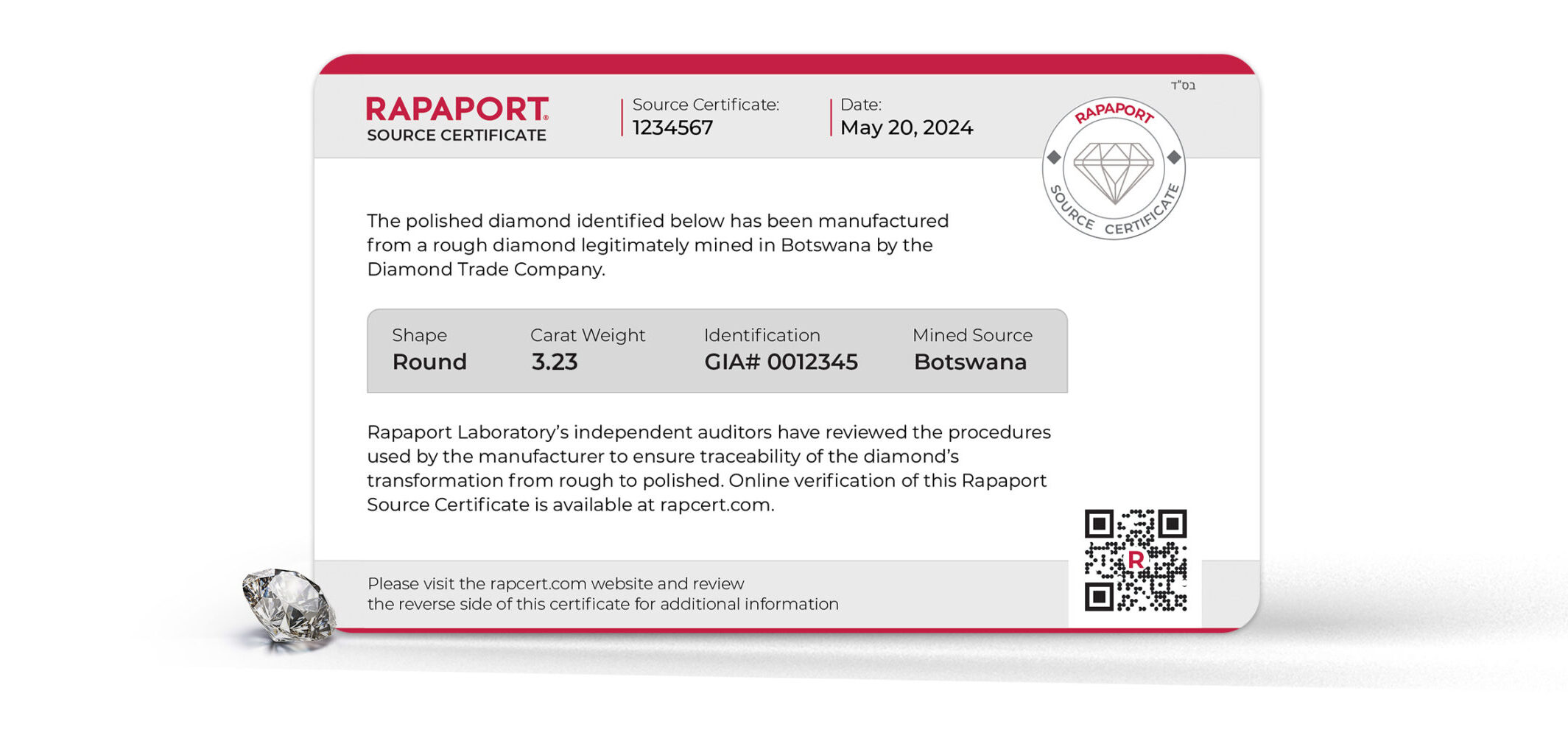
Rapaport Source Certificates
Know Where Your Diamonds Come From. Prove It Easily. Learn more about Rapaport Source certificates and how they can boost your profitability.
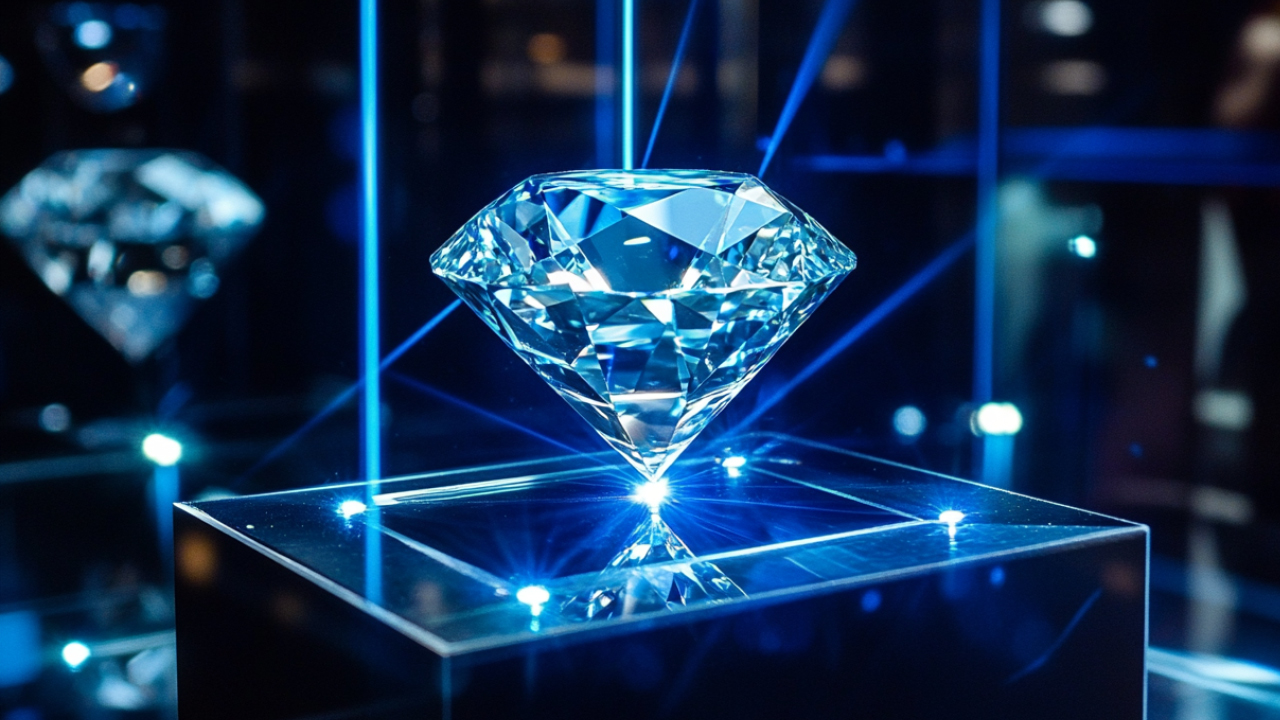
The Top Diamond-Tracking Programs and How They Work
By Avi Krawitz
Breaking down the leading options on the market, from physical tracers to user-driven blockchains.
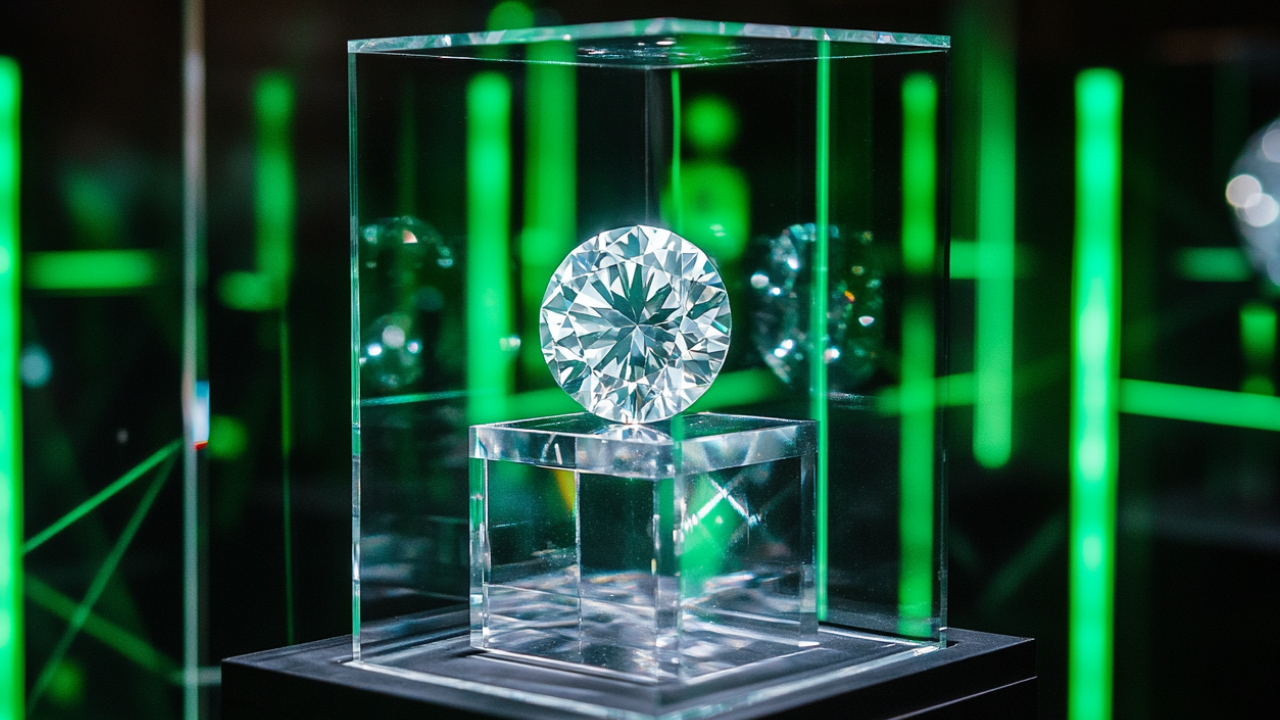
Diamond Tech Companies’ Race to Trace Goods
By Avi Krawitz
With the clock ticking to implement industry-wide tracking systems, the major players are pushing their platforms — but working together is the most likely key to success.
Register Your Interest in
Rapaport Source Certification
